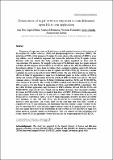Por favor, use este identificador para citar o enlazar a este item:
http://hdl.handle.net/10261/98793COMPARTIR / EXPORTAR:
 SHARE
BASE SHARE
BASE
|
|
| Visualizar otros formatos: MARC | Dublin Core | RDF | ORE | MODS | METS | DIDL | DATACITE | |

| Título: | Deactivation of sugar beet root responses to iron deficiency upon foliar iron application |
Autor: | López-Millán, Ana Flor CSIC; Moussaoui, Sawsen CSIC; Fernández, Victoria CSIC ORCID; Abadía Bayona, Javier CSIC ORCID ; Abadía Bayona, Anunciación CSIC ORCID | Fecha de publicación: | oct-2008 | Citación: | XIV International Symposium on Iron Nutrition and Interactions in Plants (XIV ISINIP, Beijing, PR China. October 11-15, 2008) | Resumen: | Responses of sugar beet roots to Fe deficiency include marked increases in the activities of the enzymes Fe chelate reductase (FCR) and phosphoenolpyruvate carboxylase (PEPC). The induction of FCR activity promotes Fe uptake by roots, whereas the induction of PEPC is a key step within a set of metabolic responses that sustain the induction of the Fe uptake system. Previous work has shown that both activities are tightly regulated by local root Fe concentrations. For instance, Fe resupply to the roots of Fe-deficient sugar beet plants reduced activities of both enzymes in root extracts by 20-50% as early as 24 h after the addition of Fe to the nutrient solution [1]. Also, there is evidence that a systemic regulation exists in Fe deficient plants, by which the leaf Fe status is able to regulate root FCR activity [2]. However, a similar regulation has not been described yet for PEPC activity. The aim of this work was to study the effects of foliar Fe application to sugar beet Fe-deficient plants on i) the activity of FCR in whole root systems of intact plants and ii) the activity of PEPC in whole root extracts. The most common sources currently used in Fe foliar fertilization practices, FeSO4 and Fe(III)-EDTA, were chosen as Fe sources. The activity of PEPC in whole root extracts decreased by 50 and 60% as early as 6 h after foliar Fe application of FeSO4 and Fe(III)-EDTA, respectively. Two days after Fe foliar application, large decreases in PEPC activities (80 and 90% for FeSO4 and Fe(III)-EDTA, respectively) were found, and no further decreases were measured overtime. Decreases in FCR activity were less marked than those of PEPC. FCR root activities measured in intact plants decreased only by 30 and 10% 6 h after foliar Fe application of FeSO4 and Fe(III)-EDTA, respectively. After 24 h of Fe foliar application, decreases in root FCR activity were maximal, 65 and 40% with FeSO4 and Fe(III)-EDTA, respectively, and no further decreases were measured. Our results show for the first time that root PEPC activity is regulated by leaf Fe concentrations, and furthermore that this enzyme is more sensitive to the leaf Fe status than FCR. Also, our data suggest that the source of Fe applied to the leaves does not cause major differences in the deactivation of root activities of FCR and PEPC in sugar beet plants grown in a growth chamber in hydroponics. This is in contrast to foliar fertilization field results, where FeSO4 has generally a better efficiency in leaf re-greening than Fe(III)-EDTA. | Descripción: | 1 .pdf (3 Figs.) copia del póster original presentado por los autores en el Simposio Internacional. Se acompaña de 1 .pdf copia del resumen oficial. | Versión del editor: | http://www.stressphysiology.com/symposia/ | URI: | http://hdl.handle.net/10261/98793 |
| Aparece en las colecciones: | (EEAD) Comunicaciones congresos |
Ficheros en este ítem:
| Fichero | Descripción | Tamaño | Formato | |
|---|---|---|---|---|
| Lopez-MillanAF_XIVIntSympIronNutr_2008.pdf | Póster presentado | 3,57 MB | Adobe PDF |  Visualizar/Abrir |
| Lopez-MillanAF_XIVIntSympIronNutr-Abst_2008.pdf | Resumen | 82,77 kB | Adobe PDF |  Visualizar/Abrir |
CORE Recommender
Page view(s)
209
checked on 19-abr-2024
Download(s)
176
checked on 19-abr-2024
Google ScholarTM
Check
NOTA: Los ítems de Digital.CSIC están protegidos por copyright, con todos los derechos reservados, a menos que se indique lo contrario.
